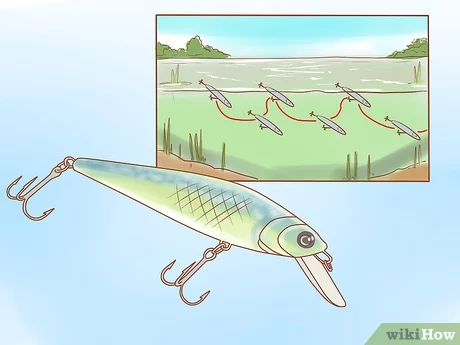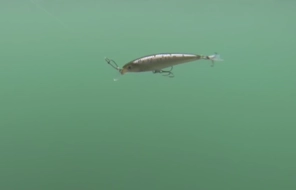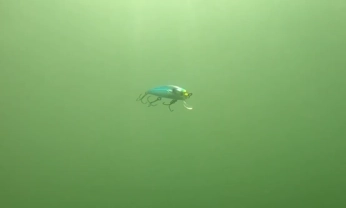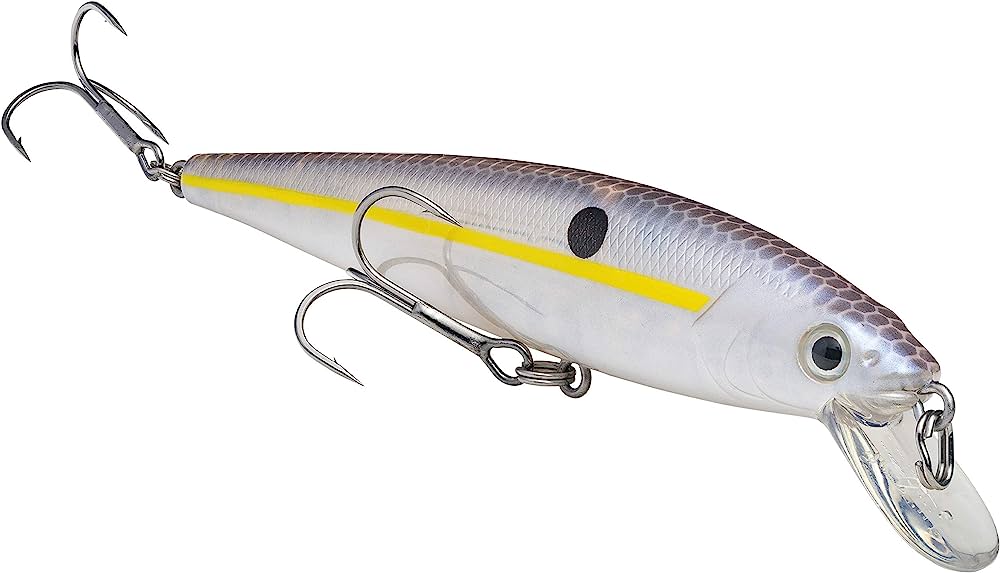To fish a jerkbait, cast towards targeted structures or cover, then employ a “jerk-pause” retrieve, using quick rod snaps followed by a pause to allow the lure to suspend or slowly rise. Vary the pause duration and jerk intensity to mimic injured baitfish, triggering predatory instincts in fish.
This article is part of my Complete Guide to Bass Fishing series that you might be interested in.
Table of Contents
How Do They Work
Jerkbaits are one of the most unique fishing lures on the market today. They have a distinctive motion that makes them appear to mimic the movement of a wounded or struggling bait fish as it tries to flee from a predator. Jerkbaits are heavily productive during the spring season when the weather is mild and bass have emerged from the depths and are looking to feed on small bait fish closer to the lake’s edges.
There are many different types of jerkbait and understanding which size and style to use at certain times of the year or in specific situations is key to having success with jerkbait fishing. The jerkbait derives its name from the jerking motion the lure makes as you retrieve it through the water.
Unlike a crankbait or other type of lure, a jerkbait is made to be fished with a specific jerking motion on the rod and giving the lure ample time to pause and further entice the fish to strike at an easy meal.

Design Features
Jerkbaits are typically long, slender, minnow-like lures with a small lip on the front, much like a crankbait. A jerk bait is not intended to dive down to the significant depths that a crankbait can and anglers will succeed better by fishing a jerkbait in depths of 10 feet or less.
Most jerkbaits will float as they are suspended, but there are suspended jerkbaits that will remain in place when you pause your retrieve so that they stay in the same water column longer.
How to Rig a Jerkbait
Hard jerkbaits are straightforward to use as they only require you to tie them directly onto your fishing line. There’s no need to use a swivel or sinker – most of the lure’s action will come from the movement of the rod in your hands.
Soft jerkbait, otherwise known as flukes, are an entirely different subject as they are often rigged weightless, or with various weight systems and retrieval methods.
This article will focus primarily on hard jerkbaits as many novice anglers widely misunderstand them.
Jerkbait Lure Techniques
The proper technique for fishing a jerkbait will often depend on the type of mood the fish are in on any given day. In the early spring, fish will often be sluggish as they slowly make their way out of the deeper water and into shallow areas where they will voraciously feed on small bait fish. The jerkbait’s ability to appear very similar to these types of small bait fish are what makes it such a productive lure during this particular time of year.
Steady Retrieve
Some anglers succeed by using a steady retrieve with a jerkbait, but this is rare. The lure is designed to be used in a sporadic, darting motion through the water. This distinct motion is caused by the angler literally ‘jerking’ the rod to one side or the other during their retrieve.
The specific level at which your bait makes these darting motions is another variable that can be altered to attract bites from sluggish fish. There may be times in the early spring when fish are not very active that you’ll actually want to use a slower, more deliberate jerking motion interspersed with longer pauses.

Jerking Retrieve
In most cases, fish will strike at the lure when it pauses through your retrieve, so pay special attention to any weight you feel on the rod as you make this jerking motion. Often, a fish will bite and you won’t realize it until you’ve jerked the rod again. In these instances, it’s vital to jerk the rod in a way that won’t rip the lure out of the fish’s mouth.
Finding the right temperature with your jerkbait is the key to a successful day on the water. Sometimes, a faster retrieve with more vigorous darting motions will have a better effect on enticing fish to bite. Pay close attention to the speed and intensity you retrieve your jerkbait with throughout different times of the year.

As the spring months wind on and the bass spawn gets closer, many fish will feed heavily and aggressively attack anything they see that remotely looks like a bait fish. At this time, jerkbaits are their most productive of any other time of year.
| Technique | Situation |
|---|---|
| Straight Retrieve | Clear water, high visibility |
| Twitching | Stained or muddy water, aggressive bass |
| Suspending | Cold water, lethargic bass |
| Stop-and-Go Retrieve | Pre-spawn, post-spawn, and around structure |
| Diving and Rising | Around submerged vegetation or drop-offs |
| Finesse Presentation | High-pressure fishing situations, heavily-fished areas |
| Dead Sticking | Extreme cold or high-pressure situations |
When to Fish a Jerkbait
One of the most important things to remember about jerkbaits is that they vastly differ from crankbaits. While crankbaits can be run through open water and produce many strikes, jerkbaits are better suited for being fished close to structure or over ledges where bass will wait for their next meal.
During the spring or fall, jerkbaits will be the best lure you can have in your tackle arsenal. Buying a good variety of jerkbaits is essential to gauge better what fish are willing to bite on a specific day. In these milder months, fish usually hang out in medium depths, around 8 to 16 feet. Fish in this water column will typically be more apt to bite at a darting bait fish that appears to be wounded or aimlessly swimming through the water.
Jerkbaits are much less effective during the summer and winter when fish are more likely to retrieve deep water and escape extreme cold temperatures. In most cases, a jerkbait can’t reach such depth and will be much more productive during the mild months of spring and fall.
For cold water fishing you may want to consider a deep diving crankbait.

Target Areas
Jerkbaits are most productive in shallow-water areas of any lake. It’s better to stick to areas filled with some grass or other structure where bass will usually lie in wait for their next meal, or might simply use the shade to escape the sunlight.
Fishing jerkbaits over points can usually be the best strategy as you can cover much greater depth changes on both sides of the point where fish are likely to hang out. Focus your efforts along rocky shorelines and points and areas that might be flat or sandy.
You can also succeed by fishing a jerkbait along areas with significant depth changes. It’s best to fish perpendicular to these depth changes in a way that spreads out and covers more of the area than you might by fishing parallel. Jerkbaits can also be very productive around docks at certain times of the year when fish will retreat under these docks to avoid warmer water and sunlight.
Suspended Jerkbait
A suspending jerkbait is one of the most productive lures you can have at certain times of the year. During the mild spring and fall months, when fish will be suspended at medium depths that aren’t shallow or deep, a suspended jerkbait can entice them to bite. There is no specific method to using these types of jerkbait; you should fish them with the same variety of cadences that you would any other jerkbait.
The only difference between a normal jerkbait and a suspended model is that the suspended jerkbait will not float to the top when it is paused in the water. This means you can fish a larger water column longer by using a suspended jerkbait.
Remember to not be in a hurry as you retrieve your suspended jerkbait as you can experience a bite as virtually any part of your retrieve.
Conclusion
I hope you have enjoyed this article showing some jerkbait tips. There is a clear difference in technique between clear water and stained water, warm water and cold water. Whether you are targeting walleye or smallmouth bass, you will have success with either soft or hard jerkbait lures.

